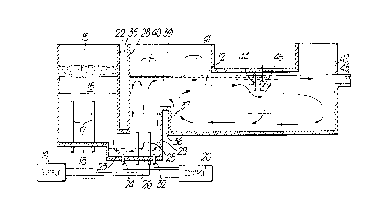Une partie des informations de ce site Web a été fournie par des sources externes. Le gouvernement du Canada n'assume aucune responsabilité concernant la précision, l'actualité ou la fiabilité des informations fournies par les sources externes. Les utilisateurs qui désirent employer cette information devraient consulter directement la source des informations. Le contenu fourni par les sources externes n'est pas assujetti aux exigences sur les langues officielles, la protection des renseignements personnels et l'accessibilité.
L'apparition de différences dans le texte et l'image des Revendications et de l'Abrégé dépend du moment auquel le document est publié. Les textes des Revendications et de l'Abrégé sont affichés :
| (12) Brevet: | (11) CA 2018740 |
|---|---|
| (54) Titre français: | FUSION DU VERRE |
| (54) Titre anglais: | GLASS MELTING |
| Statut: | Périmé et au-delà du délai pour l’annulation |
| (51) Classification internationale des brevets (CIB): |
|
|---|---|
| (72) Inventeurs : |
|
| (73) Titulaires : |
|
| (71) Demandeurs : |
|
| (74) Agent: | FINLAYSON & SINGLEHURST |
| (74) Co-agent: | |
| (45) Délivré: | 1999-03-30 |
| (22) Date de dépôt: | 1990-06-11 |
| (41) Mise à la disponibilité du public: | 1990-12-13 |
| Requête d'examen: | 1994-02-10 |
| Licence disponible: | S.O. |
| Cédé au domaine public: | S.O. |
| (25) Langue des documents déposés: | Anglais |
| Traité de coopération en matière de brevets (PCT): | Non |
|---|
| (30) Données de priorité de la demande: | ||||||
|---|---|---|---|---|---|---|
|
Cette invention concerne une cuve de fusion de verre composée d'une enceinte de fusion, d'une enceinte peu profonde de conditionnement à flux continu, d'une enceinte peu profonde d'affinage et d'une colonne montante entre l'enceinte de fusion et l'enceinte d'affinage. Le verre fondu est chauffé dans la colonne montante par des électrodes centrées près de la base de celle-ci. Des capteurs de température déterminent la température du verre fondu pénétrant dans la colonne montante par un étranglement ainsi que sa température près de la base du muret aval de ladite colonne, et l'apport de chaleur est réglé de manière à induire dans cette colonne un flux toroïdal.
A glass melting tank has a melting chamber, a shallow uniflow
conditioning chamber, a shallow refining chamber and a riser
chamber between the melting chamber and refining chamber.
Heat is input to glass in the riser chamber by electrodes
located centrally in the riser chamber near the base of the
riser chamber. Temperature sensors sense the temperature
entering the riser chamber through a throat and near the base
of a downstream wall of the riser chamber and the heat input
is controlled to produce torroidal flow in the riser chamber.
Note : Les revendications sont présentées dans la langue officielle dans laquelle elles ont été soumises.
Note : Les descriptions sont présentées dans la langue officielle dans laquelle elles ont été soumises.

2024-08-01 : Dans le cadre de la transition vers les Brevets de nouvelle génération (BNG), la base de données sur les brevets canadiens (BDBC) contient désormais un Historique d'événement plus détaillé, qui reproduit le Journal des événements de notre nouvelle solution interne.
Veuillez noter que les événements débutant par « Inactive : » se réfèrent à des événements qui ne sont plus utilisés dans notre nouvelle solution interne.
Pour une meilleure compréhension de l'état de la demande ou brevet qui figure sur cette page, la rubrique Mise en garde , et les descriptions de Brevet , Historique d'événement , Taxes périodiques et Historique des paiements devraient être consultées.
| Description | Date |
|---|---|
| Inactive : CIB de MCD | 2006-03-11 |
| Inactive : CIB de MCD | 2006-03-11 |
| Inactive : CIB de MCD | 2006-03-11 |
| Inactive : CIB de MCD | 2006-03-11 |
| Le délai pour l'annulation est expiré | 2000-06-12 |
| Lettre envoyée | 1999-06-11 |
| Accordé par délivrance | 1999-03-30 |
| Inactive : Taxe finale reçue | 1998-12-16 |
| Préoctroi | 1998-12-16 |
| Un avis d'acceptation est envoyé | 1998-09-08 |
| Lettre envoyée | 1998-09-08 |
| Un avis d'acceptation est envoyé | 1998-09-08 |
| Inactive : Renseign. sur l'état - Complets dès date d'ent. journ. | 1998-09-01 |
| Inactive : Dem. traitée sur TS dès date d'ent. journal | 1998-09-01 |
| Inactive : Approuvée aux fins d'acceptation (AFA) | 1998-08-14 |
| Toutes les exigences pour l'examen - jugée conforme | 1994-02-10 |
| Exigences pour une requête d'examen - jugée conforme | 1994-02-10 |
| Demande publiée (accessible au public) | 1990-12-13 |
Il n'y a pas d'historique d'abandonnement
Le dernier paiement a été reçu le 1998-06-08
Avis : Si le paiement en totalité n'a pas été reçu au plus tard à la date indiquée, une taxe supplémentaire peut être imposée, soit une des taxes suivantes :
Les taxes sur les brevets sont ajustées au 1er janvier de chaque année. Les montants ci-dessus sont les montants actuels s'ils sont reçus au plus tard le 31 décembre de l'année en cours.
Veuillez vous référer à la page web des
taxes sur les brevets
de l'OPIC pour voir tous les montants actuels des taxes.
| Type de taxes | Anniversaire | Échéance | Date payée |
|---|---|---|---|
| TM (demande, 7e anniv.) - générale | 07 | 1997-06-11 | 1997-06-09 |
| TM (demande, 8e anniv.) - générale | 08 | 1998-06-11 | 1998-06-08 |
| Taxe finale - générale | 1998-12-16 |
Les titulaires actuels et antérieures au dossier sont affichés en ordre alphabétique.
| Titulaires actuels au dossier |
|---|
| PILKINGTON PLC |
| Titulaires antérieures au dossier |
|---|
| PETER JAMES WHITFIELD |
| ROBERT EMMETT TREVELYAN |